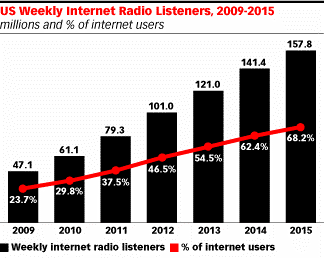It’s not digital’s golden age everywhere. Although radio took over 30 years to build its first 50 million viewers, it will take even longer to fall.
New York Public Radio recently earned a $10 million grant, the largest single gift to a public radio station- this promises to enhance its “Discover” app, which allows for online playlist creation. At the end of 2013, the privately and publicly funded non-profit National Public Radio (NPR) received a $17 million grant to expand its coverage. See what I’m getting at yet? There’s still demand for radio (with digital help) and that’s what Wall Street likes.
Don’t believe me?
Advertising revenue in digital radio is projected to rise 23% this year universally. This could save radio like digital ads on NYTimes.com, a supplement to the main product, offset loss in print ad revenue for the New York Times. Music data firms also see potential profit with Internet radio, otherwise they would not be corroborating in its build-up.

Internet radio’s incredible growth in the United States shows promise for radio as a whole.
Radio is still radio, and news is still news. Podcasts meanwhile take the audio concept of radio and put it online. A lot of what we hear online has roots in radio. It’s applying the new to the old- not vice versa.
If you look globally, old school radio remains among the most accessible mediums worldwide, where 75% of households in developing countries have access to a radio and rely on it. Only two of five have access to the Internet. In Africa, local radio grew 360 percent between 2000 and 2006 and community radio skyrocketed 1,386 percent. Meanwhile, radio survived- even grew- in Russia, from 37.7 million listeners to 39.2 million since 2008. It was the only traditional medium to do so.
Political movements around the world still use radio too. Syrian opposition used pirate radio to broadcast their message, while Zello App (popular in Ukraine’s revolts) functions similarly to ham radio. More moderately, Mayor de Blasio and Governor Cuomo still take to the airwaves.
In short: Radio is the heart, and digital innovation the defibrillator.


